
477872 Pte George Francis Joseph Stacey
22nd Regiment, Oxford Rifles
The Royal Canadian Regiment
By: Capt (ret'd) Michael M. O'Leary, CD, The RCR
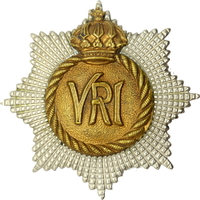
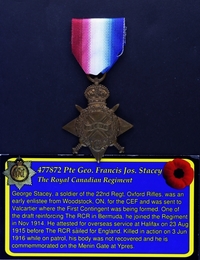
The 1914-15 Star awarded to Stacey for his Great War service, the locations of his other medals are unknown.
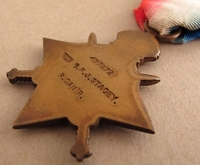
The reverse of Stacey's 1914-15 Star, showing the naming style.
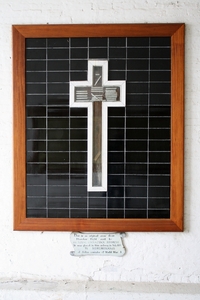
The battlefield Memorial Cross, as originally mounted on the archway wall of Wolseley Barracks (London, Ont.).
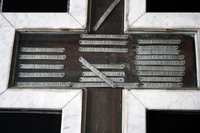
The names of Royal Canadians who died and were buried near Stacey, few have known graves.
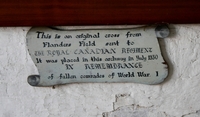
The descriptive plaque placed in the archway with the Memorial Cross.
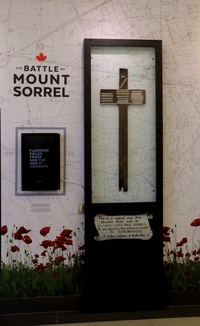
The battlefield Memorial Cross, on display at The Royal Canadian Regiment Museum (London, Ont.).
George Francis Joseph Stacey was born in Woodstock, Ontario, on 29 Sep 1894. Stacey's family, led by parents George and Louisa, can be found in the 1901 and 1911 Canadian Censuses. George is the second of three sons.
In the years before the First World War, George was serving in the local Militia regiment, the 22nd Regiment, Oxford Rifles. He appears in surviving paylists for the regiment for the Brigade Camp conducted at London from 20 to 25 Jun 1913. He was in "B" Company commanded by Capt. A.E. Woodroofe and for his six days service Stacey was paid 85 cents per day, plus 75 cents for a subsistence allowance totalling $5.85.
Stacey also appears in the 22nd Regiment's annual paylist for service between March and November 1914. he completed 12 days of paid time on parade. At 85 cents per day, he earned $10.20 which was supplemented by an extra 15 cents per day Efficiency Pay for a total of $12.00.
When Canada committed to sending troops to the First World War, General Sam Hughes, the Minister of Militia and Defence, decided to muster trained Militia officers and soldiers at Camp Valcartier in Quebec and reorganize them into a field force that was independent of the existing Militia command structures. The 22nd Regiment at Woodstock formed a contingent for Valcartier and George Stacey was one of the early volunteers from from the regiment.
The London Advertiser, in its edition of 22 Aug 1914, reported on the departure from Woodstock of the Canadian Expeditionary Force (C.E.F.) contingent from the 22nd Regiment, Oxford Rifles:
"Farewell at Woodstock
"(Canadian Press.]
"Woodstock, Ont., Aug. 22. — Woodstock said good-bye to her contingent of Canadian volunteers at noon today, when 65 of the members of the Twenty-second Regiment Oxford Rifles entrained for Valcartier, The contingent was escorted to the station through streets lined with citizens. At the station there was a civic farewell, and Mayor Hobson, on behalf of the city, presented each volunteer with a sum of money and assured them that those dependent upon them would be well looked after. The Seventh Regiment of London and the St. Thomas contingent were on the same train and were given a rousing send-off."
As troops were being massed at Camp Valcartier to form the battalions of the First Canadian Contingent, a draft of approximately 400 men was despatched to bring The Royal Canadian Regiment up to its authorized strength. Stacey was one of these men and was enlisted with The RCR at Bermuda on 4 Nov 1914, his service being recognized from 5 Sep 1914. This delay between joining the unit and being formally enlisted was caused after a period during which the status of these soldiers joining The RCR was in question regarding pay levels and regarding serving with or in a Permanent Force unit. He was given the regimental number 16084.
On 11 Sep 1914, The Royal Canadian Regiment sailed for Bermuda where they would serve for a year on garrison duty. The Regiment relieved the 2nd Battalion, Lincolnshire Regiment, which sailed immediately for England. On 12 Aug 1915, The RCR was relieved in turn by the arrival of the 38th Overseas Battalion from Canada. The RCR returned to Halifax for a stay of only a week. During this time, the Regiment was re-attested for overseas service. Although The RCR had just spent a year in Bermuda, there were concerns regarding the applicability of the soldiers' Permanent Force enlistments for wartime deployments. This was, perhaps, prompted by the idea that a man on a P.F. three-year engagement could choose not to re-engage and the Government would be obligated to bring him home. Enlistment in the CEF, on the other hand, was for the "Duration of War." Accordingly, the soldiers of The RCR were re-attested, signing CEF attestation papers in August 1915 before sailing for Europe.
Stacey attested for service in the Canadian Expeditionary Force (C.E.F.) with The RCR at Halifax, N.S., on 23 Aug 1915. A 21 year old knitter, Stacey was described on his attestation paper as 5 feet 10 inches tall, weighing 149 pounds, with a 34 1/2-inch chest, a dark complexion, brown eyes, and black hair. His religious denomination was Roman Catholic. Stacey identified his mother, Mrs. G.H. Stacey, as his next of kin. A soldier of the Canadian Militia when he volunteered for his unit's draft to go to Valcartier in 1914, Stacey claimed three years prior service with the 22nd Regiment, Oxford Rifles, on his attestation form.
The RCR sailed from Halifax on 26 Aug 1915 aboard the S.S. Caledonian, the same ship that had brought them home from Bermuda. Disembarked at Plymouth, England, on 6 Sep 1915, the Regiment went to Shorncliffe for training.
On 28 Sep 1915, Stacey would receive a new C.E.F. service number to replace the regimental number he received on enlisting with The RCR. While serving in the C.E.F., his service number would be 477872. Since the Regiment received its C.E.F. numbers while at full strength and not as they were recruited, it had the interesting effect that the soldiers of the Regiment at the time were renumbered in alphabetical order.
George Stacey completed a military Form of Will on 13 Oct 1915. In this will he left all of his estate to his mother in the event that he was killed or died overseas.
The RCR disembarked at Boulogne on 1 Nov 1915. After an introductory period of training in France where companies of the Regiment went into the trenches for instructional purposes attached to units of the 2nd and 3rd Canadian Infantry Brigades, the winter of 1915-16 settled into the cycle of rotations in forward trenches and reserve positions that would characterize the infantry experience of the Great War. Between January, 1916, and the first days of June, the Regiment would cycle through the forward line of trenches twelve times, each rotation being about four days between relief operations. Like many soldiers of the war, Stacey's experience was one of the steady cycle in and out of the trenches, without major incidents that necessitated entries in his service record.
On the night of 31 May 1916 the Regiment would go into the front lines at Mount Sorrel. The regimental history (Fetherstonhaugh, 1936) describes the intense days that followed:
"In the front line of The Royal Canadian Regiment astride the Menin Road, the night of June 1 passed without notable incident. The Battalion bombers threw grenades into the German trenches and the enemy retaliated by bombing a post on the extreme left of "A" Company. A few casualties resulted from these exchanges, but there was less shelling than usual and the Battalion, standing to in the cool dawn of a lovely summer's day, noted, a diarist testifies, that birds were singing in the air and in the grass and that over the Salient, if an occasional rifle shot and the even less frequent burst of a shell were ignored, peace seemed for the time to have established a beneficent dominion.
"At 8.30 a.m., however, the misleading sense of peace and security vanished as the bombardment that heralded the German attack began. In the main, the shelling was concentrated to the right of The Royal Canadian Regiment's line, but the fire of a number of batteries was soon diverted to the unit's area and by 10.30 a.m. communication between Battalion Headquarters and the companies and between the companies and their isolated posts had been broken. In these circumstances, the bearing and behaviour of the men became a matter of the utmost importance. The Battalion was untried in battle, a test was obviously impending, and, owing to the disruption of communications, no one could tell what responsibilities might fall to the lot of the most junior commanders. Anxiously, therefore, but confidently, officers of the unit watched the men and never was anxiety more promptly allayed or confidence more abundantly justified. From the beginning, the old, trained, Permanent Force noncommissioned officers and men faced the situation calmly and collectedly, an example in which they were so closely followed by their non-Permanent Force comrades that all doubt as to the Battalion's worthily upholding the name and reputation of The Royal Canadian Regiment at once disappeared.
"All morning on June 2, the shelling to the right continued and in the unit's own area much damage was effected. Little accurate news was received, but by early in the afternoon the Regiment knew that the Patricias had suffered severely. The left company of the Patricias was standing fast on The Royal Canadian Regiment's right; what was happening further to the right was largely a matter of rumour and conjecture.
"Then, from the German lines, the 22nd Reserve Regiment launched a sharp attack, which was repulsed by the rifle and machine-gun fire of the Regiment and the company of the Patricias on the right. Under the feet of the men of The Royal Canadian Regiment as they fired into the advancing waves of the enemy were four heavily charged mines, but they were unaware of these and, for some unknown reason, the mines were not exploded. Accordingly, the German waves were broken by a blast of fire and driven back, with heavy losses, to the trenches whence they had come. A second time the enemy attacked with courage and determination, but again the "Canadian fire was too much for them. The men of the attacking line hesitated and stopped, then broke and fled, leaving the ground strewn with dead and wounded. …
"After the attacks had been beaten off, the Regiment, under increased shell fire, maintained its sector of the front line. At 5.30 p.m. a platoon, under Lieut. Heron, was ordered by Lieut.-Col. Hill to proceed to the help of the company of the Patricias on the right. This platoon reached the Patricias' position at 6.05 p.m., but was told that its services would not be required, whereupon it returned to its own lines. Shortly thereafter artillery fire on the front died down almost to normal, but at 8.30 p.m. it increased again and simultaneously a series of gorgeously coloured rockets rose from the German lines, apparently signals for a renewal of the afternoon's attacks. …
"After three-quarters of an hour of concentrated fire, the German bombardment died down. Shrapnel burst over the area at intervals throughout the night, but high explosive was absent until, at 1.30 o'clock on the morning of June 3, the intense bombardment was renewed. Again the Regiment prepared to meet an attack, but again, after a prolonged period, in which a number of men were killed and wounded, the fire died down without any sign of movement from the enemy trenches.
"At about this time, the gallant remnant of the Patricias on the right was compelled to retire from its position in the old front line, leaving the right flank of The Royal Canadian Regiment in the air. This was disconcerting from the Regiment's point of view, but, owing to the stabilization of the whole front bv the counter-attacks of the night before, was not disastrous.
"After noting that the unit's right flank was left uncovered at approximately 9 a.m., the Battalion Diary states that, with the exception of intermittent bombardments, "nothing of importance took place on the unit's front for the remainder of the day." The exception, however, is noteworthy, for the area was heavily shelled at intervals and the Regiment suffered sharply, the casualties including Lieut. F.R.L. de Salis, killed by shrapnel, and Lieut. E.E.N. McCallum, severely wounded while conducting a reconnaissance in the direction of Yeomanry Post. Of the two scouts who took part in this reconnaissance, one was instantly killed and the other was badly wounded. Ignoring his own wounds, Lieut. McCallum bandaged the injured scout and carried him to the Regiment's lines, as it was not safe to leave him for stretcher-bearers to find in the exposed position where he had fallen. With all others of the unit's wounded, Lieut. McCallum and the man he had rescued were evacuated to the rear that night. Meanwhile, a reconnaissance, similar to that carried out by Lieut. McCallum's party, was conducted by a party under Lieut. J. M. Pauline, who brought in a report of great value.
"For the next two days, the Regiment maintained its position in the line. On June 4, desultory shelling was endured, with concentrated bombardments at intervals, the casualties from these including Lieut. T.F. Morrison, who was wounded in the arm. At 10.30 a.m. on June 5, an intense bombardment badly damaged the right section of the Battalion's front line, but the Lahore guns in support retaliated and the German fire soon died down.
A brief item published in the London Free Press edition of 21 Jun 1916 reported: "George Stacey received word that his son, Corp. George Stacey, had been killed by a shell on June 3. He, with a lieutenant and two other soldiers, were sent on a dangerous errand, and while crossing the open a shell came over, killing Stacey instantly and wounding two others." Comparing this brief description to the narrative of the regimental history, it is possible that Stacey was one of the scouts who accompanied Lieut. E.E.N. McCallum.
The Regiment's War Diary entry for 8 Jun 1916 notes the cost of the battle: "Our casualties during tour in trenches were 1 Officer and 23 other ranks killed, 5 Officers and 116 O.R. Wounded and 14 O.R. missing, making a total of 159 all ranks. The 14 missing were afterwards located in various Field Ambulances."
George Stacey was killed in action on 3 June 1916. He was buried on the battlefield near where he fell along with 20 other soldiers of The Royal Canadian Regiment. The site of their graves was marked by a battlefield memorial cross with their names impressed on metal strips attached to the crossbar of the cross. The ground where they were buried continued to be fought over and when it came time to exhume the bodies and rebury them in one of the designated war cemeteries, most could not be positively identified. A Graves Registration Company annotation on a Commonwealth War Graves Commission document reads: "Menin Road South Military Cemetery, 3/4 mile East of Ypres. "Memorial Cross Only." His name appears on Memorial Cross to N.C.O.s and Men of R.C.R. (Killed in Action) erected in this Cemetery."
With no body recovered, Stacey became one of many soldiers of the war with no known grave. His death is commemorated on the Menin Gate in Belgium.
Stacey did not make any Pay Assignments and he had no dependent eligible for Separation Allowance. He drew small amounts of pay but let the remainder accrue on his pay account, which totaled $209.53 at the time of his death. At a private's daily rate of pay, this constituted almost seven months' pay. This amount was forwarded to Canada in November, 1916, for settlement.
For his service in the C.E.F., Stacey was entitled to receive the 1914-15 Star, the British War Medal and the Victory Medal. These were despatched to his father, Mr. G.H. Stacey, at 254 Delatre St., Woodstock, Ont., in March and July 1921. Stacey's family would also receive the Memorial Plaque and Scroll and a silver Memorial Cross would be sent to Stacey's mother. The Cross and Plaque would be despatched in 1920 and 1922, respectively.
On 7 Mar 1929, a copy of the applicable section of the Menin Gate Memorial Register was sent to Mrs. Stacey, it reads:
"STACEY, Pte. G.F.J., 477872. Royal Canadian Regiment. 3rd June, 1916."
In July, 1930, the battlefield cross with the names of Stacey and other Royal Canadians was sent to The Royal Canadian Regiment. Kept at the Regimental Headquarters at Wolseley Barracks, London, Ontario, it was displayed for many years behind glass in the arched carriageway entrance to the Barrack square. In 2012, after the carriageway had been enclosed and converted into the main entrance of The Royal Canadian Regiment Museum, the cross was put back on display very close to the position it had held since the 1930s.
Pro Patria
Visit a randomly selected page in The O'Leary Collection (or reload for another choice):
- The O'Leary Collection; Medals of The Royal Canadian Regiment.
- Researching Canadian Soldiers of the First World War
- Researching The Royal Canadian Regiment
- The RCR in the First World War
- Badges of The RCR
- The Senior Subaltern
- The Minute Book (blog)
- Rogue Papers
- Tactical Primers
- The Regimental Library
- Battle Honours
- Perpetuation of the CEF
- A Miscellany
- Quotes
- The Frontenac Times
- Site Map
QUICK LINKS
The O'Leary Collection—Medals of The Royal Canadian Regiment
Newest additions:
![]()
![]() SB-12725 Private Henry "Hank" Ard
SB-12725 Private Henry "Hank" Ard ![]()
WIA at Hill 187, Died of Wounds in Japan
![]()
![]() 2355331 Lance Corporal Albert Lorking
2355331 Lance Corporal Albert Lorking
Wounded in action, later a War Amps representative.
![]()
![]() 4334 / 477996 Pte Isaac Hamilton Wilcox
4334 / 477996 Pte Isaac Hamilton Wilcox
Permanent Force, South Africa, and C.E.F.
![]()
![]() 477019 Private Harold Ashcroft
477019 Private Harold Ashcroft
Transferred to the Tunnelers.
![]()
![]() 734231 Private Clark D. Thompson
734231 Private Clark D. Thompson ![]()
The older Thompson brother, killed in action.
![]()
![]() 733849 Private Norman Parker Thompson
733849 Private Norman Parker Thompson
The younger Thompson brother; post-war service in the Special Guard.
![]()
![]()
![]() A305 / 400305 Private Andrew Walker
A305 / 400305 Private Andrew Walker ![]()
"Previously reported Wounded, now Killed in Action."
![]()
![]() 823298 Pte Thomas Patrick Steele, M.M.
823298 Pte Thomas Patrick Steele, M.M. ![]()
… for gallant conduct in the field …
![]()
![]() P13066 Sergeant Harold Thompson
P13066 Sergeant Harold Thompson
Instrumental Soloist for over 20 years of Canadian Army service.
![]()
![]() 9609 / 477728 Private Albert Edward Piper
9609 / 477728 Private Albert Edward Piper
"Arrived from England as a STOWAWAY …"
